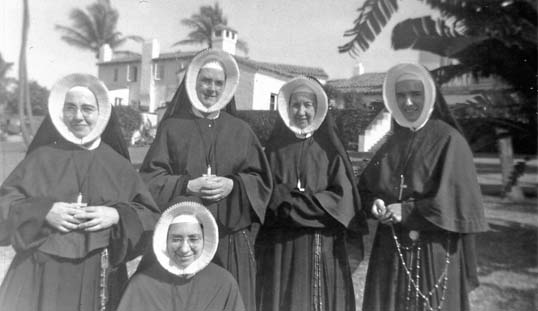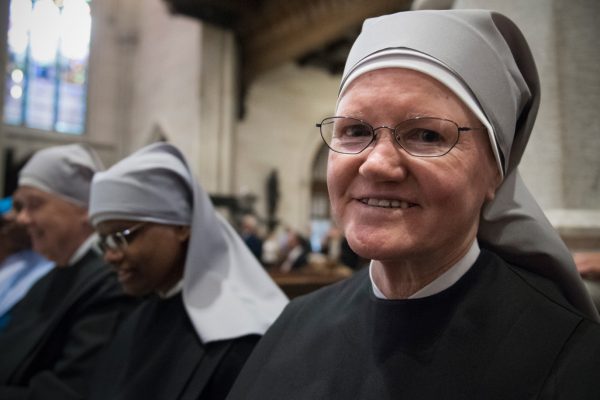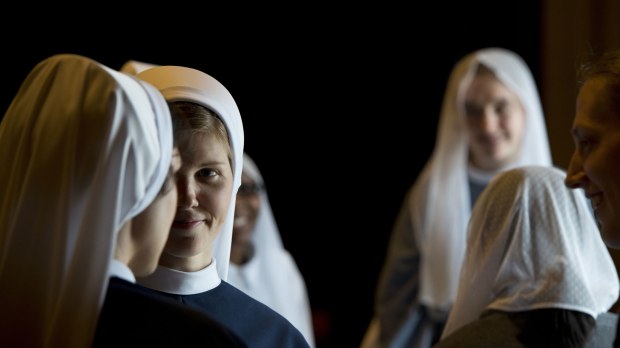On social media, the subject of nuns and sisters, and who are the “authentic” ones, can get people screaming at each other like almost nothing else. There are some who insist that the only “real” nun is a habit-wearing one, and others who argue that the “real” sisters are the ones who have shed the habit and taken on a full engagement with the world, times and trends.
The truth lies somewhere in the middle: the authentic religious life must have within it elements of commonality, prayerfulness and contemplation in order to foster strength within the community, but must also be attuned to (as opposed to “in-tune with”) the times, if a group is to render clear-headed service to the Church.
Putting monastic orders aside, because monasticism is very different from the apostolic religious life, it’s worth thinking back, in a very general way, to how most (not all) female religious orders were formed and how their communities developed spiritually and socially.

Usually a religious order grew out of identified need. The Little Sisters of the Poor developed through the simple action of one French woman, Saint Jeanne Jugan, seeing a poor, elderly woman on the street and taking her into her home. Jugan soon saw that the indigent poor were being neglected and she took a beggar’s steps — both in the Church and the secular world — to make a difference.
Similarly, Saint Therese Couderc, foundress of the Sisters of the Cenacle, saw female pilgrims in need of safe lodgings, education and spiritual direction and took action.

Both the Little Sisters and the Cenacle Sisters were co-incidentally formed by ordinary French women who listened to the promptings of love and the Holy Spirit. As they pursued their callings, other women asked to join them and share in the work. Both orders evolved into a “contemplative/active” model that had become (mostly) the norm for “active” religious orders: the women worked “outside” in the public — among-and-in-service-to the laity — but beyond that work they would separate, living and praying together as a community, with daily Mass and some amount of liturgical prayer, silence and recreation. The idea was that in order to sustain their ministries, which were arduous, the sisters needed the stability of a place to live and opportunities for both individual and communal spiritual respite. The taking of vows further stabilized the communities — they knew who would be in their numbers, what their gifts were and where they might best be of use to work — and female apostolic orders flourished, particularly from the 19th century until midway through the 20th century, when the post-war Church seemed to be abundantly rich in vocations to the priesthood and religious life.
The social and sexual upheaval of the 1960s, combined with a Second Vatican Council that meant to open the windows of the Church for a bit of fresh air and encountered a whirlwind, brought changes to the contemplative/active model. As career opportunities broadened, and artificial contraception “freed” them, the numbers of women considering the religious life dropped. Religious women read the Council documents, specifically Gaudium et spes and Lumen gentium, and found within them a call for further evolution and definition of the religious life, one that involved — among other things — a broader involvement with the People of God, and a return to the roots of their charisms.
One Council document that rarely gets mentioned when the subject of habits arises is Perfectae Caritatis, the Second Vatican Council’s Decree on the Adaptation and Renewal of Religious Life, which counseled in favor of adapting religious habits in practical ways:
The religious habit, an outward mark of consecration to God, should be simple and modest, poor and at the same time becoming. In addition it must meet the requirements of health and be suited to the circumstances of time and place and to the needs of the ministry involved. The habits of both men and women religious which do not conform to these norms must be changed.
Perfectae Caritatis never said “abandon the habit,” but left it to each community to interpret their mission and determine their dress-needs accordingly.

For some that meant shedding the habit, which had become an anachronistic reflection of what had been the “ordinary” wardrobe of a foundress. As a Cenacle Sister once explained to me, the pleated headpiece and bonnet they wore until the mid-1960s had nothing to do with “custody of the eyes” as some might imagine, but was simply a traditional reflection of what Couderc and her secular contemporaries wore. Their purple capes were designed not with a mind to penance, but because the abundant local flora of Lalouvesc allowed for the plentiful weaving of purple cloth. For these sisters, whose charism is all about retreat-giving, hospitality and spiritual direction, it made a great deal of sense for them to abandon such outmoded garb, which would almost seem pretentious, given their work. With few exceptions, most of these sisters are identified by the broad gold cross they wear as a pin or necklace.

The Little Sisters of the Poor also, at first, wore the garb of their foundress, and with the recommendations of the Council, they took a second look at their habits. Their charism is one of companionship to the indigent elderly — along with the ordinary vows of poverty, chastity and obedience, they take a unique vow of hospitality. They house, feed, engage with and love people who are often ignored and forgotten by families and friends. The sisters continue Saint Jeanne Jugan’s determined reliance upon Providence for all of their needs, and so they still go begging, every day. For them, a modified, dignified habit makes a great deal of sense — it facilitates recognition for their older guests who can sometimes get confused, and when they are begging, they are literally wearing their credentials and making themselves easily memorable (and easy to spot) to the merchants and builders they go to with their needs.

Read more:
Please stop fixating on what women wear
While an argument for the need for the habit’s visual witness can be made, the (reasonably) unhabited Sisters of the Cenacle and the (just-as-reasonably) habited Little Sisters of the Poor personify the great “both/and” of Catholicism; they provide vital service to the Church, and to the world beyond the Church, and to suggest that one group is “liberal” while the other is “conservative” is to cheapen the important work they do with political labels that do nothing but divide and distort. They are not “liberal” or “conservative” women; they are Catholic women. Their decisions to wear a habit or not are carefully considered and speak to their spiritualities and charisms, and not always in obvious ways, so judging them is silly and sometimes uncharitable.
Neither community, by the way, exclusively serves Catholics; both groups eventually extended their outreach to include men, and also non-Catholics. This last may place them outside the sentiments of the government, but it places them squarely within Christ’s mandate to “love God with your whole heart, mind and soul, and to do unto others as one would have them to unto you.”
Interestingly, the foundresses of both orders found themselves relegated to the background as their communities began to thrive. As human politics and privileges inserted themselves into the questions of leadership — as they always do — both Jugan and Couderc were pushed into lesser, more menial positions within their communities, and they stayed there. Both accepted that with astounding grace and humility, believing the work was more important than themselves. Both are included in a pretty exclusive roster, nowadays, while the shooting stars who pushed them aside simply flamed out. There’s a lesson there, perhaps, for all of us.

Read more:
Sisters, nuns, aspirants, postulants, novices: What does it all mean?

